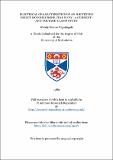Files in this item
Electrical characteristics of an identified insect motoneurone cell body : a current- and voltage-clamp study
Item metadata
| dc.contributor.advisor | Pitman, Robert | |
| dc.contributor.author | Nightingale, Wendy Denise | |
| dc.coverage.spatial | 181 p. | en_US |
| dc.date.accessioned | 2018-06-14T14:11:27Z | |
| dc.date.available | 2018-06-14T14:11:27Z | |
| dc.date.issued | 1989 | |
| dc.identifier.uri | https://hdl.handle.net/10023/14077 | |
| dc.description.abstract | 1. The electrical characteristics of the cell body of an identified excitatory motoneurone (cell 3) from the cockroach (Periplaneta americana) have been studied under current- and voltage-clamp. 2. Under voltage-clamp depolarising command pulses evoked an outward current which increased with the magnitude of the command step up to approximately +100mV, a component of the current developed more slowly and took longer to reach a maximum. With increasing depolarisation the outward current response fell to a lower level before further increasing. This current response gave rise to a characteristic N-shape I-V relationship. The position of the negative conductance region depends on the time current measurements are taken after the onset of the command pulse. 3. Externally applied cadmium (1mM) or manganese ions (5mM) abolished the slowly developing current responsible for the hump in the I-V relationship. These results indicate that calcium ions are required for the activation of this component of the outward current. Verapamil (50?M) also reduced this current component and appeared to be non-specific in reducing another current component. Furthermore, verapamil caused inactivation of the remaining current which was more marked for long duration (500ms) command pulses. 4. Externally applied TEA+ (at concentrations greater than 25mM) blocked the calcium-dependent current and a calcium-independent component. Under current-clamp TEA+ (50mM) unmasked a broad action potential. 5. Externally applied aminopyridines did not enhance excitability under current-clamp. Under voltage-clamp aminopyridines had significant effect in shifting the voltage dependence of the hump in the I-V relationship toward more negative potentials. 6. When holding at -90mV and stepping to more positive potentials there was no indication of an early, fast, transient component similar to IA. If present at all, IA made only a minor contribution to the total outward currents. 7. A double command pulse regime was used to study tail currents whereby a standard pre-pulse (pulse (I)) was immediately followed by a test pulse (pulse (II)) to various command potentials. Tail current measurements were taken during pulse (II). The tail currents showed strong outward rectification and were severely reduced in saline containing cadmium ions (ImM). 8. The tail-current reversal potential was dependent on the pulse (I) magnitude and duration. Preliminary results indicated that increasing the pulse (I) magnitude caused a negative shift in reversal potential. Increasing the pulse (I) duration from 10ms to 50ms caused a positive shift in the reversal potential equivalent to a two-fold increase in extracellular cation concentration. 9. A five-fold increase (from 3.1 to 15mM) in external potassium ion concentration produced a small and variable shift in reversal potential, which did not conform to that predicted by the Nernst equation. A five-fold decrease (from 235 to 47mM) in external chloride ion concentration had little effect on the tail current reversal potential but did cause a slight reduction in the outward currents. Furthermore, the voltage dependency of the hump in the I-V relationship was shifted toward more negative potentials. 10. Action potentials induced by intracellular citrate injection were only slightly enhanced by a four-fold increase (from 9 to 36mM) in external calcium ion concentration. They were reversibly reduced to a graded spike in saline containing verapamil (10?M) and reversibly abolished by manganese ions (40mM), but were relatively unaffected by sodium-free saline. These observations suggest that calcium ions were the major ion carrying the inward current under these conditions. 11. Carbon dioxide-induced action potentials were reversibly reduced to a graded spike in sodium-free or manganese saline (40mM) whereas tetrodotoxin (50nM) irreversibly abolished action potentials for wash period up to 20mins. These observations suggest that both calcium and sodium ions were responsible for the inward current under these conditions. 12. The regenerative component of the axotomy-induced action- potentials was reversibly reduced in sodium-free saline and only partially reduced with some broadening in calcium-free or manganese saline (40mM). Either treatment alone was insufficient to completely abolish or reduce the action potential to a graded spike. A combination of Na-free saline with manganese ions (40mM) caused a more complete block by reducing the regenerative component to a graded spike. These results suggest that sodium ions, and to a lesser extent, calcium ions were responsible for the inward current under these conditions. | en_US |
| dc.language.iso | en | en_US |
| dc.publisher | University of St Andrews | |
| dc.subject.lcc | QH645.N5 | en |
| dc.subject.lcsh | Cells—Electric properties | en |
| dc.title | Electrical characteristics of an identified insect motoneurone cell body : a current- and voltage-clamp study | en_US |
| dc.type | Thesis | en_US |
| dc.type.qualificationlevel | Doctoral | en_US |
| dc.type.qualificationname | PhD Doctor of Philosophy | en_US |
| dc.publisher.institution | The University of St Andrews | en_US |
This item appears in the following Collection(s)
Items in the St Andrews Research Repository are protected by copyright, with all rights reserved, unless otherwise indicated.

